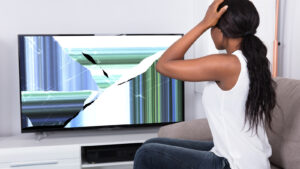A cracked TV screen can be a source of frustration and inconvenience, often leaving you with a hefty repair bill or the need to purchase a new television. However, there are steps you can take to potentially repair a cracked TV screen yourself, depending on the extent of the damage and your level of comfort with DIY repairs. This guide will walk you through the process of assessing the damage, deciding on a course of action, and carrying out the repair if feasible.

Step 1: Assess the Damage
Before diving into any repair attempts, it’s crucial to assess the extent of the damage. Not all cracks are created equal, and understanding the severity can help you decide the best course of action.
1. **Surface Cracks**: These are minor cracks that only affect the outer layer of the screen and don’t impact the display. They are often repairable with a screen repair kit.
2. **Deeper Cracks**: These penetrate the inner layers of the screen, causing issues with the display such as lines, dead pixels, or black spots. Repairing these cracks may require professional help or a full screen replacement.
3. **Spider Web Cracks**: These extensive cracks cover a significant portion of the screen, often making it difficult or impossible to view the display. In such cases, replacement is usually the only viable option.
Step 2: Gather the Necessary Tools and Materials
If the damage is minimal and you’re confident in your ability to perform the repair, you’ll need the following tools and materials:
– Screen repair kit (for minor surface cracks)
– Microfiber cloth
– Isopropyl alcohol
– Plastic card or a similar tool
– Replacement screen (for more severe damage)
Step 3: Repairing Minor Surface Cracks
For minor surface cracks, a screen repair kit can be a simple and effective solution. Follow these steps:
1. **Clean the Screen**: Use a microfiber cloth and isopropyl alcohol to gently clean the cracked area. Ensure the screen is dry before proceeding.
2. **Apply the Repair Kit**: Follow the instructions provided with the screen repair kit. Typically, this involves applying a resin or adhesive to the cracked area and using a plastic card to smooth it out.
3. **Let it Cure**: Allow the repair to cure as per the kit’s instructions, usually for a few hours to a day. Avoid using the TV during this time to ensure the repair sets properly.
Step 4: Replacing the Screen
For deeper cracks or extensive damage, replacing the screen might be necessary. This process is more complex and requires caution:
1. **Order a Replacement Screen**: Ensure you order a replacement screen that matches the make and model of your TV.
2. **Disconnect the TV**: Unplug the TV and place it on a flat, stable surface.
3. **Remove the Bezel**: Use a screwdriver to carefully remove the bezel (the frame around the screen). Be cautious of any clips or screws that hold it in place.
4. **Disconnect Cables**: Gently disconnect any cables connecting the screen to the TV’s internal components. Take note of their positions for reassembly.
5. **Install the New Screen**: Place the new screen in the TV, reconnect the cables, and reattach the bezel.
6. **Test the TV**: Plug the TV back in and turn it on to ensure the new screen is functioning correctly.
Step 5: Know When to Call a Professional
If you’re not comfortable performing these repairs yourself or if the damage is extensive, it’s best to consult a professional. A TV repair specialist can accurately diagnose the issue and provide a reliable solution, potentially saving you from further damage or additional costs.
Preventative Measures
To avoid future screen damage, consider the following preventative measures:
– **Position the TV Safely**: Place the TV in a stable location where it’s less likely to be knocked over or bumped.
– **Use a Screen Protector**: Invest in a high-quality screen protector to shield the screen from minor impacts and scratches.
– **Be Cautious with Cleaning**: Use appropriate cleaning materials and avoid applying excessive pressure to the screen.
Conclusion
Repairing a cracked TV screen can be a manageable DIY project for minor damage, but more severe cracks may require professional assistance or a screen replacement. By carefully assessing the damage and following the appropriate steps, you can extend the life of your TV and potentially save on costly repairs or replacements. Always prioritize safety and accuracy when attempting any repair, and don’t hesitate to seek professional help when needed.
Leave a Reply